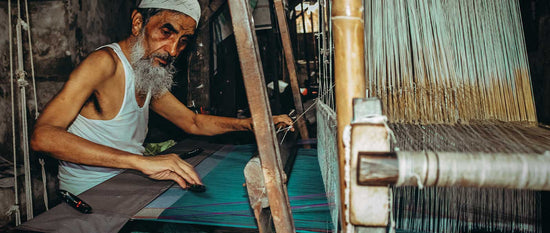Your Cart is Empty
Bed
A column with no settings can be used as a spacer
Link to your collections, sales and even external links
A column with no settings can be used as a spacer
Link to your collections, sales and even external links
From Invention to Revolution: The Ultimate Guide to the Spinning Jenny
23 min read

Table of content
How the Spinning Jenny Changed the Textile Industry Forever Evolution of Textile Machinery 6 facts about the Spinning Jenny Who invented the Spinning Jenny The Early Life Of James Hargreaves Inventing the Spinning Jenny The Mechanics of the Spinning Jenny Impact on the Textile Industry Spinning Jenny and the Industrial Revolution Global Impact of the Spinning Jenny: An Expanded Global Perspective Economic and Social Shifts: The Impact of the Spinning Jenny Resistance to and Legacy of the Spinning Jenny What other inventions did the Spinning Jenny lead to? The Luddite Movement and the Spinning Jenny Why Was It Called The spinning Jenny? Legacy and Modern Relevance: The Spinning Jenny and Industry 4.0 Innovations Inspired by History: Tracing the Legacy of the Spinning Jenny
Quick Takeaways
Revolutionary Invention :The Spinning Jenny was a groundbreaking invention by James Hargreaves in 1764 that revolutionized the textile industry. It enabled a single worker to spin multiple threads at once, significantly increasing productivity and efficiency in yarn production. This invention was pivotal in transitioning from handcrafted textile production to mechanized processes.
Catalyst for the Industrial Revolution :The introduction of the Spinning Jenny was crucial in the early stages of the Industrial Revolution. It enhanced textile manufacturing and spurred further technological developments and innovations, such as the Water Frame and the Spinning Mule. This shift helped establish Britain as the global textile production and industrial technology leader during that era.
Economic and Social Impact :The Spinning Jenny significantly reduced labor costs and changed the economic landscape of the textile industry. It made textiles more affordable and accessible, increasing consumption and demand. Socially, it contributed to major shifts such as the growth of the working class, urbanization, and the rise of factory-based labor, fundamentally changing the way people lived and worked.
Resistance and Legacy :The introduction of labor-saving machines like the Spinning Jenny was met with resistance from skilled workers, culminating in the Luddite movement. These workers feared job loss and the degradation of craftsmanship due to mechanization. Despite the initial opposition, the Spinning Jenny's adoption continued and it left a lasting legacy on the industrial landscape, illustrating the complex relationship between technological advancement and workforce dynamics.
Cultural and Historical Significance: The Spinning Jenny influenced technological and economic spheres and left a cultural imprint that echoed through history. Its role in the Industrial Revolution has been studied and reflected in historical, cultural, and educational contexts, showcasing its enduring relevance in discussions about technology, economy, and society.
How the Spinning Jenny Changed the Textile Industry Forever
The Spinning Jenny is a significant invention in the history of the textile industry, as it revolutionized the way the yarn was produced, making the process more efficient and faster.
Inventor: James Hargreaves
Invention: Spinning Jenny
Date of Invention: 1764
Location: Oswaldtwistle, Lancashire, England
6 quick interesting facts about the Spinning Jenny machine
- Inventor: The Spinning Jenny was invented in 1764 by James Hargreaves, a British weaver, and carpenter from Oswaldtwistle, Lancashire, England. Hargreaves named the device "Jenny" after his daughter or possibly as a derivation of the word "engine."
- Mechanism: The Spinning Jenny was a hand-powered, multi-spindle spinning machine that allowed the operator to spin multiple threads simultaneously. It used a row of spindles arranged on a sliding carriage moved by a hand crank. As the carriage moved, the spindles twisted the fibers (typically cotton or wool) into yarn.
- Impact on the textile industry: The Spinning Jenny significantly increased the productivity of yarn production, as one worker could now spin multiple threads at once. This reduction in labor requirements led to lower production costs, making textiles more affordable. It also contributed to the shift from home-based textile production to larger mills and factories.
- Industrial Revolution: The Spinning Jenny played a crucial role in the early stages of the Industrial Revolution, which began in the late 18th century in Britain. The increased efficiency in textile production fueled the growth of the cotton industry and helped establish Britain as the world's leading textile manufacturer. The invention also influenced further innovations in spinning machinery, such as the water frame, spinning Mule, and spinning frame.
- Social and economic implications: The widespread adoption of the Spinning Jenny and other machinery in the textile industry led to significant social and economic changes. Many skilled textile workers lost their jobs as machines replaced their roles. This displacement contributed to the growth of the working class, urbanization, and the rise of factory-based labor.
- Luddite movement: The introduction of labor-saving machinery, like the Spinning Jenny, sparked resistance from some workers who feared the loss of their jobs and way of life. This opposition culminated in the Luddite movement of 1811 through to 1816, where groups of textile workers in England destroyed machinery in protest against the perceived threat to their livelihoods.
The Spinning Jenny was a groundbreaking invention that transformed the textile industry.
While it increased production efficiency and led to cheaper textiles, it also contributed to significant social and economic changes, including job displacement and the rise of factory-based labor.
Technological Advancements and Iterations: Evolution of Textile Machinery
Before the invention of the Spinning Jenny in 1764, the textile industry's technological landscape was characterized by manual labor and simple tools. Textile production, particularly spinning, was predominantly done using the spinning wheel—a device that could only produce one thread at a time and required considerable skill and physical effort to operate. This method was labor-intensive and inefficient, limiting the scale and speed of textile production.
The introduction of the Spinning Jenny marked a significant shift. This invention allowed a single worker to spin multiple threads simultaneously, thus multiplying productivity without a corresponding increase in effort or labor. The original Spinning Jenny had eight spindles, enabling the production of eight threads at once, a number that increased in later models.
However, the Spinning Jenny was just beginning a series of innovations that would further revolutionize textile manufacturing. The Water Frame, invented by Richard Arkwright in 1769, was another pivotal development. Unlike the Spinning Jenny, which was powered by human effort, the Water Frame utilized water power, which allowed it to operate continuously and with greater force. This invention was particularly adept at producing stronger, thicker threads suitable for warp, the longitudinal threads in a piece of woven fabric, which were previously difficult to produce mechanically.
Following the Water Frame, Samuel Crompton's Spinning Mule, invented in 1779, combined features of both the Spinning Jenny and the Water Frame. The Spinning Mule could produce fine, strong thread in large quantities. It used a series of spindles mounted on a mobile carriage that moved back and forth to draw out and spin the fibers into yarn. Introducing the Spinning Mule significantly enhanced quality and efficiency, bridging the gap between the quantity produced by the Jenny and the quality offered by the Water Frame.
These inventions, the Spinning Jenny, Water Frame, and Spinning Mule, collectively revolutionized the textile industry, transforming it from a craft-based to an industrial-scale operation. Each machine introduced improvements that significantly enhanced different aspects of yarn production:
- The Spinning Jenny increased the number of threads spun, reducing labor per unit of yarn.
- The Water Frame enhanced the strength and consistency of the yarn, which was crucial for industrial uses.
- The Spinning Mule combined quantity and quality, allowing for the efficient production of fine yarns for various types of textiles.
This machinery evolution increased production capacities and reshaped the type of labor required in textile factories, transitioning from skilled artisanal work to less skilled, more repetitive tasks. This shift in labor requirements paved the way for the modern textile industry, characterized by high efficiency, large scale, and significant capital investment in machinery.
The development of these machines illustrates a key period in industrial history, where innovation was driven by the need to overcome human labor limitations and meet the growing demand for textile products both domestically and globally.
This period of rapid technological advancement laid the groundwork for further industrialization and set the standards for manufacturing that would eventually spread to other sectors.

The Early Life Of James Hargreaves the spinning Jenny Inventor
James Hargreaves was born in 1720 in Oswaldtwistle, Lancashire, England.
He lived in a rural area where textile production was predominantly a cottage industry, with people weaving and spinning at home.
Hargreaves was a carpenter and weaver by trade, giving him insight into the challenges and inefficiencies of the spinning process at that time.

Inventing the Spinning Jenny
The exact circumstances of Hargreaves' invention of the Spinning Jenny remain unclear, but it is generally believed that the idea came to him around 1764.
At the time, spinning was a labor-intensive and time-consuming process, as it was typically done on a spinning wheel that could only produce one thread at a time.
Hargreaves sought to address this inefficiency by creating a machine that could spin multiple threads simultaneously.
The Mechanics of the Spinning Jenny
- Basic components: The Spinning Jenny consists of a frame, a row of spindles, and a sliding carriage. The spindles hold the threads while the sliding carriage helps to twist and spin the fibers into yarn.
- Preparing the fibers: Raw fibers (typically cotton or wool) are bound to untangle and align them before spinning. The prepared fibers are then attached to the spindles on the machine.
- Spinning process: The operator turns a hand crank, which moves the sliding carriage back and forth along the row of spindles. As the carriage moves, the spindles spin, twisting the fibers and creating tension. The tension causes the fibers to stretch and twist together, forming yarn.
- Winding the yarn: Once the fibers have been spun into yarn, they are wound onto a bobbin, a cylindrical device for storing the yarn. The operator can then replace the full bobbins with empty ones to continue spinning more yarn.

Impact on the Textile Industry
The Spinning Jenny had a profound impact on the textile industry. Its ability to significantly increase productivity and reduce labor costs led to its widespread adoption, making textiles more affordable.
It also contributed to the shift from home-based textile production to larger mills and factories.
The invention of the Spinning Jenny and other spinning machines, such as the water frame and the spinning Mule, solidified Britain's position as the world's leading textile manufacturer during the early stages of the Industrial Revolution.
What part did The Spinning Jenny play in the Industrial Revolution?
The Spinning Jenny played a significant role in the early stages of the Industrial Revolution, particularly in the context of the textile industry. Its impact can be seen in several areas:
- Increased productivity and efficiency: The Spinning Jenny allowed a single worker to spin multiple threads simultaneously, significantly increasing productivity and efficiency in the spinning process. This innovation made it possible to produce more yarn in less time, increasing the output of the entire textile industry.
- Lower production costs: The increased efficiency brought about by the Spinning Jenny led to reduced labor costs, as fewer workers were needed to produce the same amount of yarn. This cost reduction made textiles more affordable, increasing their widespread availability and consumption.
- Shift to factory-based production: The widespread adoption of the Spinning Jenny, along with other innovations like the Water Frame and the Spinning Mule, facilitated the transition from small-scale, home-based textile production to larger mills and factories. This shift allowed for more significant economies of scale, more efficient production processes, and the further specialization of labor.
- Acceleration of the Industrial Revolution: The success of the Spinning Jenny and other textile innovations accelerated the pace of the Industrial Revolution. The increased efficiency in textile production led to a higher demand for raw materials, mainly cotton, and encouraged the development of better transportation and infrastructure systems. These advancements, in turn, drove economic growth and further industrialization.
- Influence on social and economic changes: The Spinning Jenny and other innovations in spinning technology contributed to significant social and economic changes during the Industrial Revolution. The rise of factory-based labor, urbanization, and the growth of the working class can all be linked, in part, to the impact of Spinning Jenny and similar inventions.
The Spinning Jenny played a crucial role in the early stages of the Industrial Revolution by increasing productivity, reducing production costs, and driving the shift to factory-based production. Its impact extended beyond the textile industry, influencing social, economic, and infrastructural developments defining the modern era.

Global Impact of the Spinning Jenny: An Expanded Global Perspective
The Spinning Jenny , a seminal invention of the 18th century, did far more than transform the textile industry in Britain—it catalyzed a global industrial movement. As the precursor to modern mechanized production, the Spinning Jenny's influence extended across Europe and leaped across the Atlantic to the United States, seeding the ground for widespread industrial advancements.
In Europe, the adoption of the Spinning Jenny varied significantly between countries due to differences in industrial capabilities and economic structures. In France and Germany , the Spinning Jenny was integrated into existing textile industries, albeit slower than in Britain due to less access to raw materials like cotton and a higher reliance on wool, which did not initially benefit as much from Jenny's capabilities. However, the technological principles embodied in the Spinning Jenny —increased productivity through mechanization—were quickly understood and adopted, leading to the development of tailored versions of spinning machines that better suited local needs and materials.
Across the ocean in the United States , the Spinning Jenny arrived during a period of significant economic transformation. By the late 18th century, American entrepreneurs and inventors were eager to adopt and adapt British textile technologies, motivated by the growing demand for cotton textiles. The Spinning Jenny was crucial in establishing the United States' textile industry, particularly in New England , which became a hub for textile manufacturing. American versions of the Spinning Jenny were often modified to enhance their efficiency and adaptability to the diverse and expansive American market.
Moreover, the Spinning Jenny's role in advancing global trade cannot be overstated. By dramatically increasing the production capacity of yarn, the Jenny reduced the cost of textile manufacturing and made these goods more accessible and affordable worldwide. This democratization of textile access played a pivotal role in expanding global trade networks.
It not only facilitated the export of textiles but also the import of raw materials such as cotton from plantations in the American South and colonies around the world, further integrating global economic systems.
Additionally, the widespread adoption of the Spinning Jenny and its mechanistic principles laid the groundwork for the spread of industrial technology globally. It served as a tangible demonstration of how mechanization could enhance production efficiencies in not just textiles but in a multitude of other industries, paving the way for the broader Industrial Revolution that would take hold in the 19th century.
In summary, the global impact of the Spinning Jenny was profound, influencing not just the textile industry but also the broader contours of global economic and industrial development . Its legacy is seen in the way modern industries are structured and how global trade networks continue to function, underscoring the enduring influence of this revolutionary invention .
Economic and Social Shifts: The Impact of the Spinning Jenny
The Spinning Jenny, introduced during the mid-18th century, significantly altered the economic landscape of the textile industry and had broader implications for the Industrial Revolution. By mechanizing the process of spinning yarn, this invention drastically reduced the labor required to produce textiles, influencing the pricing structure and economic dynamics of the period.
Economic Ramifications of Reduced Labor Costs
One of the most immediate economic impacts of the Spinning Jenny was the reduction in labor costs. As the machine allowed a single worker to handle multiple spindles simultaneously, fewer workers were needed to produce the same amount of yarn as traditional hand spinning. This labor efficiency lowered production costs and increased output, leading to a surplus of textiles on the market.
The reduced cost of production made textiles more affordable, catalyzing a shift in the market. Lower prices expanded access to textile goods for a broader population segment, stimulating demand and driving further industrialization in the textile sector. This price adjustment contributed significantly to the economic phenomenon known as the "price revolution," where the general cost of commodities decreased due to increased production efficiencies.
Impact on the Overall Economy
The Spinning Jenny's influence extended beyond the textile industry, impacting the overall economy during the Industrial Revolution.
The reduction in textile prices had a deflationary effect on the economy, increasing real incomes and changing consumption patterns. As textiles became cheaper, money was freed up for expenditure in other areas, promoting growth in diverse sectors like agriculture, construction, and emerging industries.
Moreover, the surplus produced by mechanized spinning fueled exports, improving trade balances and infusing more capital into the economies of industrializing nations.
This capital was then invested in further technological innovations and infrastructure, reinforcing the cycle of economic growth initiated by industrial advancements like the Spinning Jenny.
Adaptation in the Labor Market
The labor market underwent significant transformations in response to the new technology.
The demand for traditional spinning skills diminished, leading to a shift in the workforce's skill set. Workers were increasingly required to oversee and maintain machines rather than engage in manual textile production.
This shift catalyzed the development of new types of employment, emphasizing machine operation and maintenance skills over traditional artisan skills.
New employment opportunities also emerged outside the textile industry. As the economy expanded and diversified, transportation, machinery, and construction sectors saw growth, requiring labor for roles that did not exist before the Industrial Revolution.
The expansion of these sectors was partly driven by the need to support the growing industrial economy, which relied on transportation networks and mechanical tools, fueling further diversification of jobs.
Social Shifts Accompanying Economic Changes
The economic changes brought about by the Spinning Jenny also precipitated profound social shifts.
The concentration of production in mills and factories fostered urbanization, drawing workers into cities and leading to the growth of urban centers.
This urbanization process was accompanied by significant changes in living conditions and social structures, with new social classes emerging, such as the industrial bourgeoisie and organized labor.
Furthermore, the shift from home-based to factory-based production altered family dynamics and social roles, particularly affecting women and children who entered the workforce in new ways.
The factory system introduced a regimented work schedule starkly different from the agricultural and home-based work rhythms previously dominating workers' lives.
The Spinning Jenny was more than a technological innovation; it catalyzed widespread economic and social transformation.
Its introduction reshaped the economic landscape, altered the structure of the labor market, and initiated significant social changes that are integral to understanding the Industrial Revolution's impact on modern economic and social systems.
Resistance to and Legacy of the Spinning Jenny
Hargreaves' invention was only sometimes welcomed. Fearing that the Spinning Jenny would render their jobs obsolete, skilled textile workers resisted adoption.
Hargreaves faced considerable opposition from local spinners, forcing him to move his family to Nottingham in 1768. He built a small spinning mill there and continued improving his invention.
Despite the initial resistance, the Spinning Jenny became widely used and is now recognized as a critical invention that helped pave the way for the Industrial Revolution. James Hargreaves' legacy lives on as one of the inventors whose work transformed the textile industry and contributed to significant social and economic changes.
What other inventions did the spinning jenny lead to?
The Spinning Jenny Spurred the development of more advanced spinning machinery in the textile industry. Here are some notable inventions that were inspired by or evolved from the Spinning Jenny:
- Water Frame: Invented by Richard Arkwright in 1769, the Water Frame was another significant spinning machine that used water power instead of human labor to drive the spinning process. This allowed for even greater efficiency and larger-scale production. The Water Frame was specifically designed to spin cotton and produced a more robust, tighter yarn than the Spinning Jenny.
- Spinning Mule: Invented by Samuel Crompton in 1779, the Spinning Mule combined the best features of the Spinning Jenny and the Water Frame. The Spinning Mule had a larger number of spindles, which enabled the production of finer, higher-quality yarn. Initially hand-powered, the Spinning Mule was later adapted to be driven by water or steam power, allowing for increased productivity and scalability in textile manufacturing.
- Spinning Frame (or Arkwright Frame): Richard Arkwright made further refinements to his Water Frame, eventually developing the Spinning Frame, a more efficient and effective machine. Like the Water Frame, the Spinning Frame was powered by water and used for large-scale yarn production.
- Self-Acting Mule (or Roberts Mule): Invented by Richard Roberts in 1825, the Self-Acting Mule significantly improved the Spinning Mule. It introduced automatic features that reduced the need for skilled labor, further increasing efficiency and productivity in textile mills.
- Ring Spinning Frame: Invented by John Thorp in 1828 and later improved by various inventors, the Ring Spinning Frame replaced the Spinning Mule as the dominant spinning technology in the late 19th century. It used a ring and traveler system to wind yarn onto the bobbins, enabling higher speeds and more consistent yarn production.
These inventions were a direct result of the innovations introduced by the Spinning Jenny, which laid the groundwork for the mechanization of the textile industry.

The Luddite Movement and the spinning Jenny
The Luddite movement was a social protest that emerged in the early 19th century in England, primarily in response to the widespread adoption of new machinery and technology in the textile industry, including the Spinning Jenny.
The Luddites, named after their possibly fictional leader Ned Ludd, were groups of textile workers who opposed the mechanization of their trade and feared the loss of their jobs and livelihoods.
The Spinning Jenny and other textile innovations like the Water Frame and the Spinning Mule contributed to significant changes in the industry, such as increased productivity and efficiency, reduced labor costs, and the shift from home-based production to factory-based production.
While these advancements led to economic growth and the availability of cheaper textiles, they also threatened the job security of skilled textile workers.
Regarding the Spinning Jenny, the Luddite movement was a reaction to the rapid technological advancements that disrupted traditional working and living methods.
Luddites saw the Spinning Jenny and other machines as direct threats to their jobs, social status, and the quality and craftsmanship of their work.
The Luddite movement peaked between 1811 and 1816 when they engaged in protest, sabotage, and violence. They would often break into factories and mills at night to destroy the machines they believed were responsible for unemployment and social displacement.
The British government responded to the Luddite unrest by deploying military forces and passing legislation that made machine-breaking a capital offense punishable by death.
In the long run, the Luddite movement could not halt the progress of the Industrial Revolution and the mechanization of the textile industry.
However, their actions remain an important historical example of the social unrest and resistance that can arise from rapid technological changes and the disruption of traditional industries and ways of life.

Why Was It Called The spinning Jenny?
The Spinning Jenny was named after its inventor, James Hargreaves. The origin of the name is not definitively known, but there are two popular theories:
- Named after his daughter: One theory suggests that Hargreaves named the spinning machine after his daughter, Jenny. This would be a way of personalizing and attributing the invention to a family member.
- Derivation of the word "engine": Another theory posits that "Jenny" is a colloquial, shortened form of the word "engine." In this context, "engine" refers to a mechanical device or machinery. Given that the Spinning Jenny was a mechanical device used for spinning yarn, this theory suggests that Hargreaves named the invention as a reference to its purpose and function.
While the exact origin of the name "Spinning Jenny" remains uncertain, both theories highlight the personal or functional aspects of the invention that James Hargreaves might have wanted to emphasize.
Legacy and Modern Relevance: The Spinning Jenny and Industry 4.0
The Spinning Jenny, a cornerstone of the Industrial Revolution, not only transformed the textile industry of the 18th century but also laid foundational principles for modern manufacturing practices, particularly as we advance into the era of Industry 4.0.
The legacy of this invention is evident in the ongoing automation and integration of intelligent technologies in production processes today.
Reflection on the Legacy of the Spinning Jenny
The Spinning Jenny introduced the concept of mechanization in manufacturing, a radical shift from manual labor to automated processes.
This transformation is mirrored in today’s manufacturing landscape, where automation and robotics dominate production lines across various industries. The principles of increasing productivity and reducing labor costs, which were revolutionary during the time of the Spinning Jenny, continue to guide modern manufacturing strategies.
The legacy of the Spinning Jenny is particularly relevant as we evaluate the efficiency of production techniques. Its introduction marked the first significant step towards scaling production capabilities, a goal that continues to drive technological advancements in manufacturing.
This historical perspective highlights the long-standing pursuit of more efficient, cost-effective, and scalable manufacturing solutions, which remains a cornerstone of industrial development.
Contemporary Relevance and Industry 4.0
As we transition into Industry 4.0, the manufacturing sector is witnessing a new revolution characterized by integrating digital technologies, automation, machine learning, and data analytics.
The Spinning Jenny’s role in initiating the first wave of industrial automation provides a valuable context for understanding these changes. Today, intelligent factories utilize AI to optimize operations, predict maintenance needs, and enhance manufacturing precision—capabilities far beyond the mechanical innovations of the past, yet fundamentally driven by the same desire to enhance productivity and efficiency.
The ongoing impact of automation, now coupled with artificial intelligence, is reshaping the manufacturing landscape. Machines that learn and adapt to varying production needs represent the current pinnacle of industrial innovation.
These systems can analyze vast amounts of data to optimize production processes, reduce waste, and even predict system failures before they occur, thus enabling a more sustainable and efficient production environment.
Lessons from the Initial Industrial Revolution
The initial Industrial Revolution, sparked by inventions like the Spinning Jenny, offers critical lessons for the current technological upheaval.
One such lesson is the importance of considering the socio-economic impacts of technological changes.
Just as the Spinning Jenny led to significant shifts in labor markets and societal structures, modern automation and AI pose challenges and opportunities for the workforce.
Policies and training programs that can help the current workforce adapt to the rapidly changing job landscape are needed, just as workers from agricultural to industrial roles were needed in the past.
Additionally, the Spinning Jenny teaches us about potential resistance to new technologies. Understanding the causes and addressing the fears related to job displacement and skills redundancy can help smooth the transition to new manufacturing technologies.
Engagement with all stakeholders, including policymakers, educators, and the workforce, is crucial to harnessing the benefits of Industry 4.0 while mitigating its challenges.
The Spinning Jenny is not merely a relic of industrial history but a precursor to the ongoing evolution of manufacturing. Its legacy offers valuable insights into the challenges and opportunities of the new era of digital automation and AI-driven production systems.
As we advance towards increasingly automated and intelligent manufacturing solutions, the lessons from the early days of industrialization remain relevant, guiding us toward a more efficient and responsive manufacturing future.
Innovations Inspired by History: Tracing the Legacy of the Spinning Jenny
The Spinning Jenny, an invention that revolutionized textile production during the Industrial Revolution, continues to inspire modern technological advancements in the industry.
The concepts introduced by the Spinning Jenny have evolved, leading to sophisticated technologies such as automated weaving looms and 3D knitting technology.
These innovations enhance productivity and efficiency and address contemporary challenges like sustainability and resource management.
Automated Weaving Looms
Automated weaving looms are direct descendants of early textile machines like the Spinning Jenny.
Modern looms incorporate advanced technologies that allow for precise control and high-speed operation, significantly increasing fabric production rates while reducing material waste.
These machines use computer algorithms to design complex patterns and adjust parameters in real time to ensure optimal thread usage and minimize defects.
By automating tasks that were once manually intensive, these looms preserve the essence of Spinning Jenny’s impact on the textile industry—transforming the manufacturing process through mechanization.
3D Knitting Technology
3D knitting technology represents a leap forward in textile manufacturing, allowing for the creation of complex, seamless garments and textiles directly from digital designs.
This technology extends the Spinning Jenny's principles by further reducing the steps between raw material and finished product.
3D knitting machines can produce complete items with minimal human intervention, reducing labor costs and production time.
Moreover, this technology offers unparalleled flexibility in design and can adapt quickly to changes in fashion trends or consumer demands, echoing the Spinning Jenny’s role in increasing production adaptability.
Addressing Modern Sustainability Challenges
The legacy of the Spinning Jenny is also evident in how current innovations tackle sustainability issues within the textile industry.
The historical push for efficiency is now paralleled by efforts to reduce the environmental impact of textile production. For instance, modern automated looms and knitting machines are designed to optimize energy use and decrease fiber waste, contributing to a reduction in the ecological footprint of textile manufacturing.
Moreover, technologies like waterless dyeing processes and fabric recycling systems demonstrate how lessons from the past can inform solutions to current problems.
Waterless dyeing, for instance, uses supercritical CO2 instead of water to fix dye to fabrics, significantly reducing water usage—a critical consideration in sustainable manufacturing.
Similarly, fabric recycling technologies, which repurpose textile waste into new materials, reflect a shift towards a circular economy, reducing the need for raw materials and minimizing waste.
These innovations play a crucial role in reducing the ecological footprint of textile manufacturing, aligning with the industry's growing focus on sustainability.
The innovations in textile manufacturing that trace their conceptual roots back to the Spinning Jenny highlight the enduring influence of historical industrial advancements.
Automated weaving looms and 3D knitting technology exemplify the evolution of mechanical principles first introduced by the Spinning Jenny and underscore the ongoing relevance of these concepts in addressing contemporary challenges.
As the textile industry continues to evolve, the integration of sustainability into technological innovations remains a testament to the lasting impact of the Spinning Jenny on modern manufacturing practices.
By learning from the past and innovating for the future, the textile industry is better equipped to meet the demands of the present while preparing for the needs of tomorrow.
In Conclusion
The Spinning Jenny was a groundbreaking invention crucial in the early stages of the Industrial Revolution, particularly in the textile industry.
By significantly increasing productivity and reducing labor costs, the Spinning Jenny contributed to the affordability and widespread availability of textiles while driving the shift from home-based to factory-based production.
Though it faced opposition from groups such as the Luddites, who feared for their jobs and the loss of traditional craftsmanship, the Spinning Jenny ultimately paved the way for further innovations in spinning technology and textile manufacturing.
Its impact extended beyond the textile industry, shaping economic growth, social change, and the development of modern industrial society.
The legacy of James Hargreaves' invention is a testament to the transformative power of technological advancements and their potential to reshape industries and the world.
Credits
Banner Image: Kmdugger, CC BY-SA 4.0
, via Wikimedia Commons
Other Blanket Blanket History Related Blogs
1. How Many Spindles Did the Original Spinning Jenny Have?
Answer: The original Spinning Jenny invented by James Hargreaves in 1764 had eight spindles, allowing it to spin eight threads simultaneously. This number increased in later versions to enhance productivity further.
2. What Materials Could the Spinning Jenny Spin?
Answer: The Spinning Jenny was primarily used to spin cotton and wool, the most common fibers available during the period of its invention.
3. How Did the Spinning Jenny Influence Modern Textile Machinery?
Answer: The Spinning Jenny laid the foundational technology for later inventions in textile machinery, including the Water Frame and the Spinning Mule, leading to the modern automated spinning processes used today.
4. What Was James Hargreaves' Profession Before Inventing the Spinning Jenny?
Answer: Before inventing the Spinning Jenny, James Hargreaves was a weaver and a carpenter, professions that gave him insights into the textile industry and the technical skills necessary to build his invention.
5. How Did the Spinning Jenny Improve Yarn Quality?
Answer: While the Spinning Jenny primarily increased production speed and efficiency, it also helped produce more consistent and even yarn, as the mechanical spinning was more uniform than hand spinning.
6. Did the Spinning Jenny Use Any Form of Power Other Than Human?
Answer: The original design of the Spinning Jenny was manually operated, primarily using human power to turn the crank. Later adaptations saw versions powered by water or steam, enhancing their efficiency.
7. What Were the Limitations of the Spinning Jenny?
Answer: The Spinning Jenny was less effective at spinning fine, high-quality yarn compared to later inventions like the Spinning Mule, which combined features of both the Jenny and the Water Frame for finer control and quality.
8. How Did the Spinning Jenny Affect Employment in the Textile Industry?
Answer: The Spinning Jenny reduced the need for labor-intensive hand spinning, leading to job losses among traditional spinners but also creating new jobs in machine operation and maintenance within burgeoning textile mills.
9. Where Was the First Spinning Jenny Used Commercially?
Answer: The first commercial use of the Spinning Jenny was in Lancashire, England, where it was initially developed and tested.
10. How Did Public Reaction to the Spinning Jenny Shape Its Development?
Answer: Public reaction, particularly from the spinning community, was mixed. Resistance from hand spinners who feared job losses led to instances of machine breaking. However, economic demand for more textiles at lower costs drove its continued development and adoption.
11. What Are Some Misconceptions About the Spinning Jenny?
Answer: A common misconception is that the Spinning Jenny alone was responsible for the mechanization of the textile industry, whereas it was actually part of a series of inventions that collectively transformed textile manufacturing.
12. How Was the Spinning Jenny Operated?
Answer: Operators of the Spinning Jenny turned a hand crank to move a sliding carriage, which caused the spindles to spin the fibers into yarn.
13. Did the Spinning Jenny Lead to Any Patent Disputes?
Answer: James Hargreaves did not initially patent the Spinning Jenny, which led to widespread imitation and use without licensing. He later attempted to enforce some control over its manufacture, which led to legal and physical conflicts.
14. How Did the Spinning Jenny Influence Factory Design?
Answer: The Spinning Jenny's ability to consolidate multiple spinning processes in one machine influenced the design of early factories, encouraging larger, more open spaces to accommodate multiple machines and streamline operations.
15. What Were the Long-Term Cultural Impacts of the Spinning Jenny?
Answer: Culturally, the Spinning Jenny symbolized the shift towards industrialization and was a catalyst for significant shifts in social structures, economic practices, and even cultural narratives about technology and progress.



















